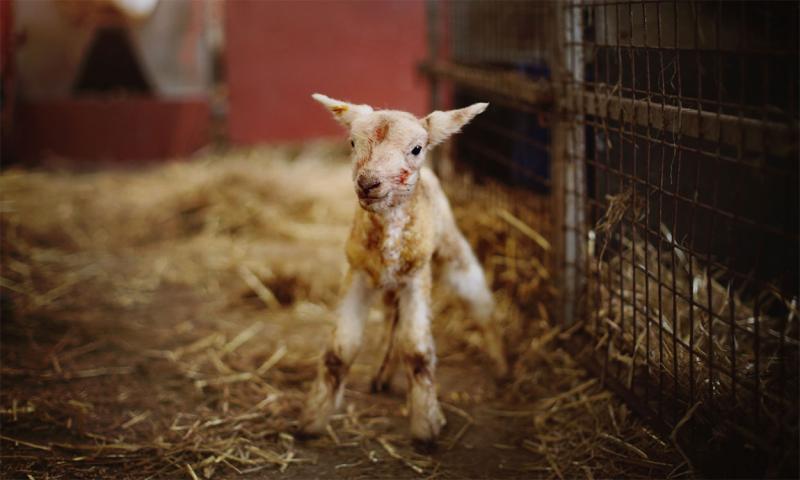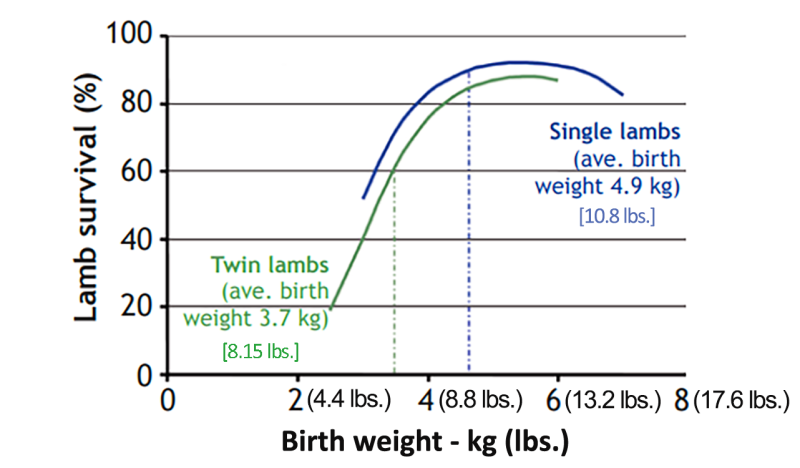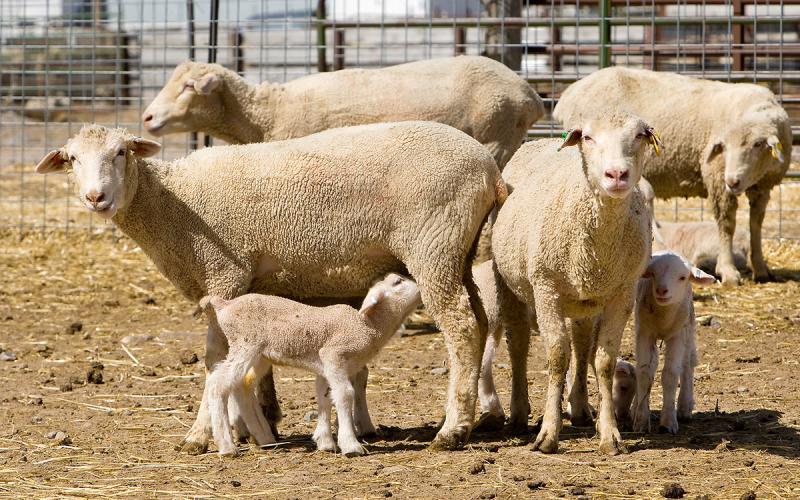
Written with contributions by Kelly Froehlich, former Assistant Professor & SDSU Extension Sheep and Goat Specialist.
Lamb mortalities result in significant loss of income to farms and ranches. Although lamb death can occur anywhere from birth to weaning, the greatest lamb mortalities occur within the first few days of life. This survivability is multifaceted, depending on genetics, behavior, physiology, and the environment, and it is closely linked with lamb birth weight. By optimizing lamb birth weights within a flock and breed, producers can help minimize lamb losses.
Within a population of sheep, lamb birth weight in relation to lamb survival is a U-shaped distribution, with the average being somewhere in the middle. Lambs falling on either end of the U-shaped distribution, so those with abnormally low or high birth weights, have a greater chance of mortality. Lower birth weigh lambs are more prone to starvation and exposure to the environment due to their high body surface to body mass ratio. In addition, those lambs have less vigor and udder-seeking behavior at birth. Higher birth weights also experience increased mortalities, this occurs through birthing injuries and reduced lamb vigor at birth, potentially due to a longer, more-difficult birthing period (dystocia). Although dystocia can be increased in higher birth weight lambs, prolific sheep birthing multiple, smaller lambs can also be a leading cause due to abnormal birth presentations and longer birth time.
Optimal Lamb Birth Weights

So, what is the optimal lamb birth weight for maximizing lamb survival? Well, it depends. Given the variability (and size) of sheep breeds across the world and the United States, that answer shouldn’t be surprising. A 1980s study looking at multiple breeds of New Zealand sheep suggested the optimal birth weight for lamb survival to between somewhere between 7.7 to 12 pounds. Recent data from mostly NZ Romney, Coopworth, and Texel sheep suggested an optimal birth weight of around 12 pounds. This is re-iterated from an Australian publication; lambs around that 12-pound mark had the greatest survival (Figure 1). This is the upper-end of the suggested optimal birth weight study from the 1980s, but could reflect the increase of ewe size.
Factors Influencing Birth Weight
Birth weight can be affected by a variety of factors including litter size, dam age/parity, ewe nutrition and ewe size. Litter size has an inverse relationship with birth weight, the more lambs in a litter, the lower the birth weight of those lambs. Younger ewes and ewes lambing for the first time tend to (but not always) have lower birth weight lambs than older and more-experienced ewes. Ewe nutrition in gestation impacts lamb birth weight. Underfed ewes not provided adequate nutrition will have smaller lambs. However, there is little support to suggest that over feeding ewes above their requirements will affect birth weight or weaning weight of those lambs. Lastly, the size of the ewe and its utero environment can impact lamb birth weights. For example, Suffolk lambs will be larger when gestated in a Suffolk ewe (larger breed) compared to a Cheviot ewe (smaller breed).
Conclusion
To increase lamb survival, lamb birth weights cannot be overlooked. An optimal birth weight for survival is going to be dependent on an individual breed (and size) of a sheep. However, there are some management factors that can help minimize or at least anticipate the birth of lambs and/or ewes that may need extra care. This includes ensuring adequate feed is provided for gestating ewes, anticipating providing extra care and attention for those younger and first-time lambing ewes, and utilizing and evaluating the genetics of rams and ewes to ensure a more-optimal birth weight for the breed of sheep.
References
- Dalton, D. C., T. W. Knight, and D. L. Johnson. 1980. Lamb survival in sheep breeds on New Zealand hill country. New Zealand Journal of Agricultural Research 23(2):167-173.
- Dwyer, C. M., J. Conington, F. Corbiere, I. H. Holmøy, K. Muri, R. Nowak, J. Rooke, J. Vipond, and J. M. Gautier. 2016. Invited review: Improving neonatal survival in small ruminants: science into practice. Animal 10(3):449-459.
- Everett-Hincks, J. M. and K. G. Dodds. 2008. Management of maternal-offspring behavior to improve lamb survival in easy care sheep systems. J Anim Sci 86(14 Suppl):E259-270.
- Kenyon, P. R. and H. T. Blair. 2014. Foetal programming in sheep – Effects on production. Small Ruminant Research 118(1):16-30.
- Curnow, M., A.N. Thompson, R. Behrendt, and J.C. Whale. 2008. Ewe management handbook: optimizing merino ewe nutrition to increase profits. Albany, W.A. : Lifetimewool.


